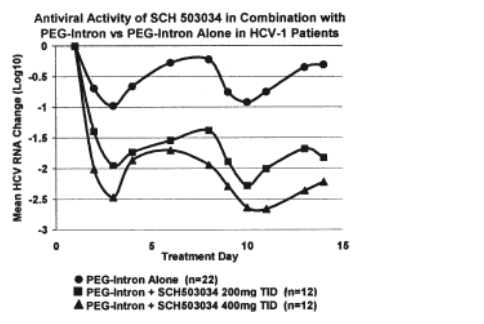 |
 |
 |
| |
Combination therapy with SCH-503034 HCV Protease Inhibitor & PegIntron in Non-Responders: phase !b study results
|
| |
| |
Reported by Jules Levin
http://www.natap.org
from AASLD
Nov 14, 2005, San Francisco
Stefan Zeuzem, Christoph Sarrazin, Saarland University Hospital, Homburg; Frank Wagner, Research Unit; Schering-Plough Research Institute, Kenilworth, NJ
SCH 503034 is a novel HCV protease inhibitor that delivers potent antiviral activity in an oral capsule formulation. In this study we compared the anti-HCV activity of SCH 503034 in combination with PEG-Intron vs SCH 503034 or PEG-Intron alone in HCV-1 PEG-Intron non-responders.
In this multi-center, open-label study, adults with HCV-1 and prior PEG-Intron ± Ribavirin failure ( <2 log reduction in HCV RNA (VL) after 12 wks) received in random sequence:
A) SCH 503034 oral capsules (200 mg or 400 mg) as a monotherapy for 7d,
B) PEG-Intron 1.5 ug/kg/QW SC as monotherapy for 14d, and
C) A + B for 14d, in a 3-way crossover design with a 3-wk washout between treatments.
Baseline HCV RNA was 6.3 logs. Alt was on average 80-82.
Study patients received the three combinations in various sequences
HCV RNA was determined daily by qRT-PCR (Taq-Man/LOQ 29 IU/ml).
As you can see from the graph below HCV RNA viral load was reduced by 2.2 log after 14 days combination dosing. Monotherapy data was reported yesterday & the Schering protease reduced HCV RNA by about 1.6 log but clearly the dose used is accompanied with concerns. In the graph below you see viral load increase after 5 days with combination 7 with protease monotherapy the viral load decline also went back up & then leveled off. Since the mean viral load reduction with the VX-950 protease was -4.4 log after 14 days dosing, at the session today I asked the presenter about looking at increased dosing in future studies & about using ritonavir to boost the HCV protease. Future studies are ongoing. In this study the 400mg dose performed better than the 200mg dose. 7 patients had 1-2 log drops with 400 mg dose & 2 patients had 2-3 log drops, but with the 200 mg dose viral load reductions were 0-1 & 1-2 logs.
HCV RNA was substantially reduced by SCH 503034 + PEG-Intron. 4/10 patients in the 400 mg combination group became HCV RNA non-detectable (<29 IU/ml) during treatment Vs 0/22 patients receiving PEG-Intron alone.

Mean maximal log10 reductions were 2.4 (range, 1-4.5) and 2.9 (range, 2.3-4.1) for 200 mg and 400 mg SCH 503034 + PEG-Intron, respectively, Vs 1.1 for PEGIntron alone. SCH 503034 monotherapy for 7d reduced HCV RNA 0.4-1.77 log10, at 200 mg TID and 0.5-2.5 log10, at 400 mg TID.
The AE profile for combination treatment was similar to PEG-Intron alone, except for a slight increase in the incidence of headache.
SCH 503034 plus PEG-Intron demonstrated potent antiviral activity in HCV-1 PEG-Intron non-responders and thus may represent a new therapeutic option for this patient population. This is being further evaluated in Phase II studies assessing 24 and 48 wks of combination treatment.
|
|
| |
| |
|
 |
 |
|
|